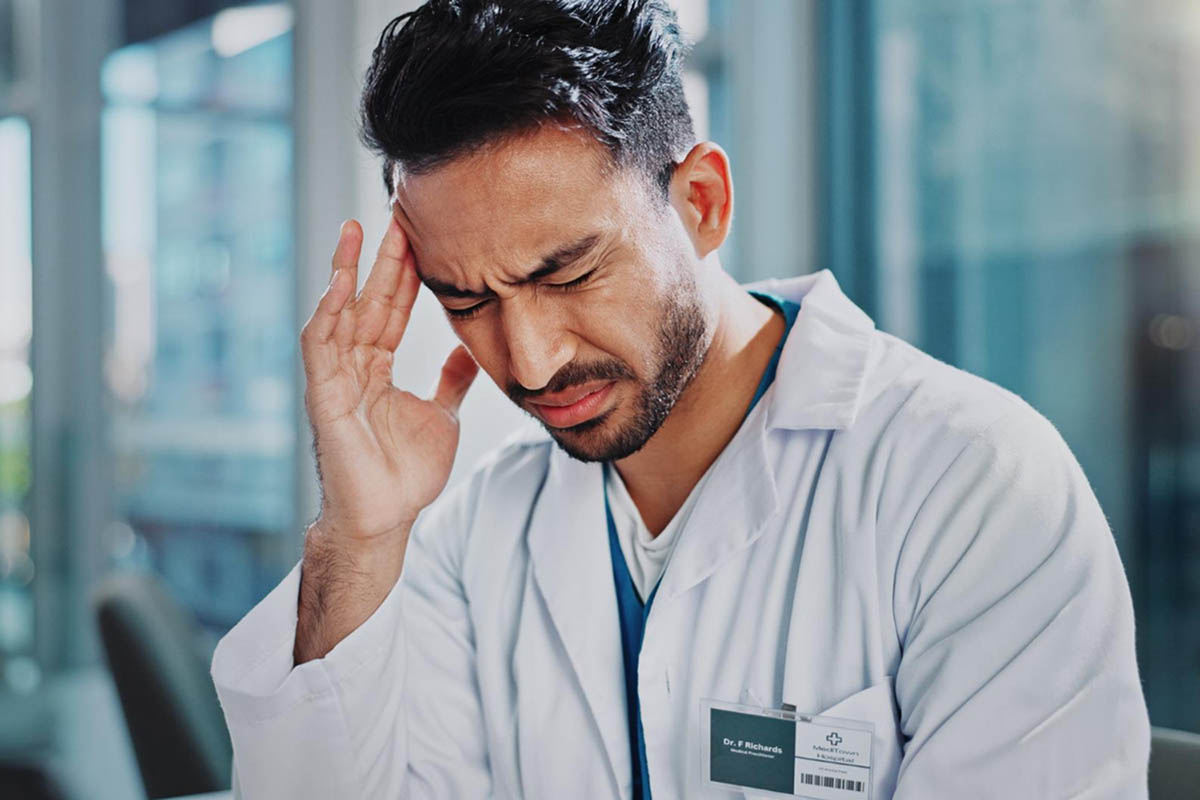The temporomandibular joint (TMJ) is an essential part of our jaw function, allowing us to open and close our mouths smoothly. It connects the jaw to the skull and supports vital actions such as chewing, speaking, and yawning. When this joint or the surrounding soft tissues become inflamed or irritated, it can lead to a condition called temporomandibular disorder (TMD). One of the most uncomfortable symptoms of TMD is TMJ headaches. These headaches are often linked to issues with the joint or the surrounding jaw muscles and can result in intense discomfort. Understanding TMJ headaches, their causes, and effective treatments is key to relieving jaw pain and improving quality of life.
What is TMJ Headache?
TMJ headaches, also referred to as TMJ-related headaches, occur when pain from the temporomandibular joint or surrounding muscles radiates into the head. These headaches are often mistaken for tension headaches or even migraine headaches due to their similar presentation, but they have distinct characteristics tied to jaw movement and muscle tension. TMJ head pain can manifest as dull or sharp, and the headache pain can extend to the neck, shoulders, and cranial regions.
Understanding what TMJ headaches feel like is crucial for proper diagnosis. TMJ headaches are typically located around the temples, behind the eyes, or near the jaw, which differentiates them from other types of headaches. Persistent pain and pressure in these areas are common symptoms of a TMJ headache. By identifying the TMJ headache location and linking it to temporomandibular disorder, healthcare professionals can provide the appropriate treatment response.
What Causes TMJ Headache?
Several factors can contribute to TMJ headaches, many of which involve the jaw, joint disorder, or related muscle tension. Below are some of the most common causes of TMJ headaches.
Teeth Grinding
Teeth grinding, or bruxism, is a major contributor to TMJ headaches. Grinding your teeth at night puts excessive pressure on the temporomandibular joint and surrounding jaw muscles, leading to jaw pain, damaged teeth, and chronic headaches. Frequent teeth grinding can wear down the soft tissues and cartilage around the TMJ, worsening joint pain and headache symptoms.
Stress
Stress is a well-known trigger for TMJ-related headaches. Stress-induced tension can cause muscle contraction in the jaw, neck, and shoulders. This leads to tension headaches and aggravates existing TMJ disorders. Chronic stress often results in jaw clenching, which overworks the chewing muscles and intensifies headache pain.
Osteoarthritis
Osteoarthritis is a degenerative joint disorder that affects the temporomandibular joint, wearing down cartilage and causing inflammation. This joint disorder can lead to TMJ headaches, as the damaged joint sends pain signals to the head. TMJ osteoarthritis often results in chronic pain, stiffness, and joint pain, which contribute to severe headaches.
Joint Hypermobility
In some cases, the TMJ may move excessively due to joint hypermobility. This condition leads to misalignment and strain, causing TMJ headaches. The instability of the joint can result in frequent headaches, as the jaw is not functioning in its correct position. Patients with joint hypermobility are at higher risk of experiencing severe TMJ-related headaches.
Osteoporosis
Osteoporosis, a condition that weakens bones, can affect the TMJ by reducing bone density and stability in the jaw. This makes the joint more prone to injury and pain, leading to TMJ headaches. Osteoporosis weakens the structural support around the TMJ, causing persistent pain and discomfort in the jaw and head.
Poor Dental Alignment
Misaligned teeth or a misaligned bite (often referred to as a bad bite) is a common cause of TMJ headaches. When the teeth do not align properly, it strains the temporomandibular joint and jaw muscles, leading to painful symptoms like jaw pain and frequent headaches. Orthodontic treatments may be required to correct the dental misalignment and relieve TMJ headache symptoms.
Food Sensitivities
Certain food sensitivities, particularly to hard or chewy foods, can trigger TMJ headaches. Chewing tough foods increases pressure on the TMJ and surrounding muscles, leading to joint pain and head pain. Avoiding foods that strain the jaw can reduce the frequency of TMJ headaches.
Infection
Although rare, infections in the jaw or surrounding tissues can cause swelling, pain, and TMJ headaches. Infections can lead to inflammation of the soft tissues, exacerbating joint pain and triggering headache symptoms.
Poor Posture
Poor posture, particularly forward head posture, can strain the muscles in the neck and jaw, contributing to TMJ disorders. When the muscles supporting the head and neck are overworked, it can lead to TMJ head pain and tension headaches. Maintaining good posture is an important part of preventing TMJ headaches.
Trauma
Physical trauma to the jaw, face, or neck can cause damage to the temporomandibular joint, leading to TMJ headaches. This could result from an accident, a fall, or even certain dental procedures. Trauma to the jaw can disrupt the function of the TMJ and cause ongoing pain in the cranial regions.
In addition to the factors already discussed, myofascial pain is a common cause of TMJ-related headaches. Myofascial pain involves discomfort in the muscles that control jaw function, particularly the temporalis muscle, which can lead to both jaw and neck pain. This type of pain often radiates, causing orofacial pain and contributing to daily headaches.
Symptoms of TMJ Headache

TMJ headaches can present in various ways, depending on the severity of the temporomandibular disorder. Common symptoms of TMJ headaches include:
- Jaw Pain: Discomfort around the jaw and face.
- Headache Pain: Aches in the temples or behind the eyes.
- Clicking or Popping Sounds: Occurs when opening or closing the mouth.
- Facial Pain: Tenderness in the cheeks, temples, or around the ears.
- Ear Pain or Fullness: Earaches or a feeling of fullness.
- Limited Range of Motion: Difficulty opening or closing the mouth.
- Chronic Pain: Persistent pain in the jaw or head. These symptoms often overlap with migraine symptoms, tension headaches, and other headache disorders, making it essential to understand the connection between the jaw and head pain.
A common sign of TMJ headaches is pain that radiates from the jaw to the neck and head, often involving the trigeminal nerve, which is responsible for transmitting pain signals from the face to the brain. This nerve is particularly sensitive in TMJ disorders and is often implicated in TMJ headaches. Additionally, some individuals experience cluster headaches or primary headaches, which can be aggravated by TMJ dysfunction.
Research has indicated that TMD pain is frequently present in individuals who experience primary headaches. A population study revealed that 27% of people with headaches also suffered from TMD pain, whereas only 15% of individuals without headaches reported TMD-related pain.
TMJ Headache Diagnosis
Diagnosing TMJ headaches requires an assessment of headache history and a thorough physical examination by a healthcare professional, often a dentist or oral specialist. This examination may include:
- Medical History Review: Understanding any past injuries, dental checkups, or previous conditions.
- Jaw Movement Observation: Checking the range of motion and any unusual sounds like clicking or popping.
- Imaging: X-rays, CT scans, or MRIs to assess the TMJ and surrounding tissues for inflammation or damage. Proper diagnosis is critical to identifying the root cause of TMJ headaches and creating an effective treatment plan.
How to Treat TMJ Headaches
Effective treatments for TMJ headaches vary depending on the severity of the disorder, the underlying causes, and individual symptoms. Treatment can range from simple lifestyle adjustments to more advanced medical interventions. Finding the right solution often involves a combination of pain management, physical therapy, and dental care. Here are some of the most common and effective treatment options for relieving TMJ headaches:
Pain Medications
Over-the-counter medications such as anti-inflammatories, ibuprofen, or acetaminophen can help reduce inflammation and relieve TMJ headache pain. For more severe pain, prescription medications may be required to manage symptoms. It’s important to consult a healthcare provider before taking any new medications, especially for chronic headaches.
Applying Ice in Jaw
Applying ice packs to the jaw can help reduce swelling and numb the painful areas around the TMJ, providing temporary relief. Cold therapy can also help ease joint pain and soothe sore muscles, especially after an attack of migraine or severe headaches.
Jaw Exercises
Performing gentle jaw exercises can help restore the correct position of the jaw, improving range of motion and relieving tension in the chewing muscles. These exercises should be done under the guidance of a physical therapist or healthcare provider.
Orthodontic Treatments
Orthodontic treatments can help correct misaligned teeth or a misaligned bite, which may be contributing to TMJ headaches. Treatment options include:
- Night Guard: A device worn at night to prevent teeth grinding and relieve pressure on the TMJ.
- Splint: An oral appliance that repositions the jaw to relieve tension and reduce headache pain.
- Orthodontic Braces: Braces may be needed to correct long-term misalignment and alleviate TMJ headaches caused by bad bite or misaligned teeth.
Physical Therapy
Physical therapy focuses on reducing tension in the jaw, neck, and shoulders. Therapists may use techniques like manual therapy, ultrasound, or electrical stimulation to improve muscle function and reduce chronic pain. Physical therapy is often combined with other conservative measures to enhance treatment response.
Physical therapy is widely considered an effective approach to treating temporomandibular disorders (TMD). Many patients with TMD often report concomitant headaches.
Surgery (in severe cases)
In rare, severe cases, surgical procedures such as open-joint surgery may be needed to repair or replace the temporomandibular joint. Surgery is usually a last resort when other treatments have not provided relief. Joint surgery is often recommended for patients with severe TMJ pain or joint damage caused by arthritis or trauma.
Beyond the treatments already mentioned, botulinum toxin injections may be used in some cases to relieve TMJ-related headaches. This treatment helps relax the jaw muscles and reduce migraine attacks triggered by TMJ issues. Bite guards, which are custom dental appliances, help by preventing teeth grinding and aligning the jaw in a way that reduces tension on the joint.
Using anti-inflammatories is a common first-line defense for TMJ headaches, as they reduce swelling and provide immediate relief. Additionally, TMJ & Sleep Therapy can be an essential part of treatment, especially for individuals who clench or grind their teeth at night. This therapy aims to improve sleep quality and reduce tension on the TMJ during rest, providing an additional headache treatment option.
Preventing TMJ Headaches
Addressing treatment implications involves understanding the underlying risk factors, such as poor posture, stress, and misaligned teeth, which contribute to TMJ headaches. Preventative measures, such as using bite guards and avoiding excessive jaw strain, can significantly reduce the frequency of TMJ headaches. Here are some helpful strategies:
Avoiding Excessive Chewing or Clenching
Chewing gum, hard candies, or biting down on non-food objects can overwork the TMJ, leading to jaw pain and frequent headaches. Limiting these behaviors can reduce strain on the joint.
Avoiding Hard Foods
Steer clear of hard-to-chew foods such as tough meats, crunchy snacks, and nuts, as these can aggravate the TMJ and trigger headache pain. Opt for softer foods that put less pressure on the jaw.
Managing Stress

Stress management techniques such as meditation, mindfulness, and exercise can help reduce tension in the jaw muscles, preventing TMJ-related headaches. Behavioral therapy can also be effective in managing stress and reducing the frequency of headache attacks.
When to See a Doctor?
If your TMJ headaches are persistent, severe, or not improving with at-home treatments, it may be time to consult a healthcare professional. They can help determine the underlying cause and recommend more advanced treatments if necessary.
Conclusion
TMJ headaches can be a painful and disruptive condition, but understanding the causes, symptoms, and treatment options can help you find relief. From adjusting your daily habits to seeking medical intervention, there are various ways to manage TMJ headaches and improve your quality of life.
At Austin Manual Therapy, we specialize in providing expert care for individuals suffering from TMJ pain. Our experienced therapists use personalized, evidence-based approaches to help relieve jaw discomfort, reduce headaches, and improve overall jaw function. Whether you’re dealing with chronic pain or a recent issue, our physical therapy in Austin focuses on treating the root cause of your symptoms, ensuring long-lasting relief and a better quality of life. Let us help you regain comfort and mobility through tailored, hands-on treatments designed to meet your specific needs.
FAQs
What does a TMJ headache feel like?
A TMJ headache often feels like a dull, aching pain around the temples, jaw, and ears. It can also involve facial soreness and difficulty chewing.
How do you fix TMJ headaches?
Treatment varies but can include pain medications, jaw exercises, orthodontic treatments, and stress management. In severe cases, surgery may be required.
How long can a TMJ headache last?
TMJ headaches can last from a few hours to several days, depending on the severity of the underlying TMJ disorder. Proper treatment can reduce the frequency and duration of these headaches.





